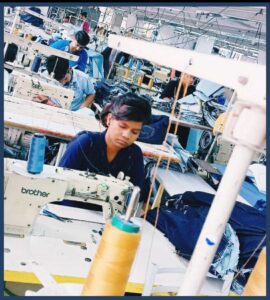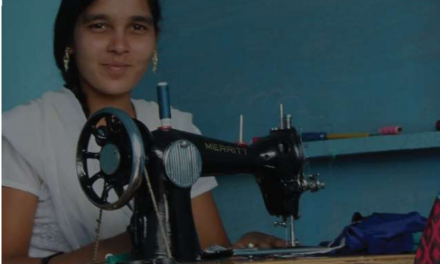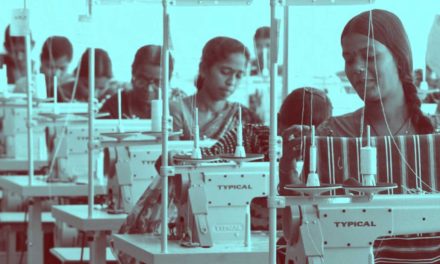In This Report, Kaveri MT Delves Into The Crucial Link Between Working Conditions In Garment Factories & The Health of Women Workers. This Is Part of Cividep’s Latest Research On Occupational Health Issues Among Bangalore’s Garment Workers
If there is one worry that plagues Geetha (name changed), it is the prospect of falling sick. “Who is going to take care of me and my children if I fall sick?” asks this 38-year-old garment worker.
Her worry is not misplaced. Despite getting a steady income, first as a helper and later as a tailor, Geetha has realised that she has been ill-prepared to deal with medical emergencies due to inadequate wages, poor working conditions, and lack of awareness about public health schemes that could have eased her financial burden. This chain of events and its link to workers’ health vulnerabilities are the focus of a recent report by Cividep.
Wage Insufficiency
Geetha’s wages remained stagnant at a mere Rs. 300 (3 €) for an 8-hour day, despite her role change from a helper to a piece-rate tailor. After fighting for fair compensation, she secured an additional Rs. 50 (0.5 €). However, when she fell sick and had to take sick leave, her employer refused to pay her last wages, claiming she would be compensated by the Employee State Insurance (ESI) scheme. Unfortunately, she didn’t receive the ESI compensation either. “If I had health insurance, I could’ve managed to take care of the household,” she says.
Adding to her troubles was her employer’s apathy towards informing her about workplace rights and social security benefits. Geetha never received overtime wages for the additional hours she worked, and though deductions for social security benefits were made from her salary, she was unaware of it due to the lack of pay slips. She also didn’t receive the ESI health card, which the employer is mandated to provide to all employees, resulting in her bearing the burden of private healthcare costs.
Failing Health Concerns
Geetha became a garment factory worker after her husband’s death in an accident seven years ago. Her chronic menstrual issues, like many other garment workers, are attributed to poor working conditions that prevent regular toilet and water breaks. “I got urinary tract infections after I started working,” she says.
While a private health clinic provided some relief initially, the infection kept recurring, leading to excessive menstrual bleeding that persisted for over a month. The medical care required significant costs, and with a monthly income of only Rs. 4,400 (48 €) after deductions for medical leave, Geetha struggled to make ends meet. Consequently, she had to pull her two daughters out of school.
After consulting several doctors, Geetha’s uterus abnormalities were finally revealed through a scan. She nearly underwent a hysterectomy, but a timely intervention by a doctor warned her about the procedure’s side-effects. With years of struggle, the bleeding is now under control with medication.
Report Points To Workplace Conditions
 Cividep’s research highlights common challenges faced by workers in the garment industry, particularly musculoskeletal issues that come from maintaining specific postures for extended periods. The stressful production environment contributes to verbal and physical violence, affecting the overall atmosphere. Women workers from low-income households endure pain to keep their livelihoods secure. Unfortunately, the consequences of such a work environment result in long-term health complications. It is this chain of events that the team tried to map in the report: ‘Worked To The Bone: Understanding Health Vulnerabilities & Healthcare Access of Women Garment Workers in Bangalore’.
Cividep’s research highlights common challenges faced by workers in the garment industry, particularly musculoskeletal issues that come from maintaining specific postures for extended periods. The stressful production environment contributes to verbal and physical violence, affecting the overall atmosphere. Women workers from low-income households endure pain to keep their livelihoods secure. Unfortunately, the consequences of such a work environment result in long-term health complications. It is this chain of events that the team tried to map in the report: ‘Worked To The Bone: Understanding Health Vulnerabilities & Healthcare Access of Women Garment Workers in Bangalore’.
Main Findings*
Musculoskeletal Issues: A significant number of workers suffer from neck pain (67%), back pain (55%), knee pain (50%), shoulder pain (50%), and limb pain (43%).
Nutrition: Nearly half of the workers identified themselves as anemic, with over 60% reporting missing one meal a day. The study also notes that 29% of the workers were underweight, while 18% were overweight.
Sexual and Reproductive Health: Menstrual irregularities were reported by 65% of respondents, with 90% stating that these issues emerged after joining the industry. Urinary tract infections affected 47% of women, and more than 50% disclosed experiencing miscarriages or abortions. Hysterectomy was discussed, with an estimated 20% having undergone the procedure.
Respiratory Issues: Dust emitted from fabrics led to respiratory problems, causing breathlessness in 26% of the respondents.
Mental Health: Stress was a prevalent issue, affecting 87% of workers. Many reported experiencing lack of appetite (66%), insomnia/sleeplessness (54%), fatigue/tiredness (65%), and recurring headaches (68%), attributing these symptoms to high production pressure and the dual burden of work and domestic responsibilities.
The study also examined the accessibility and affordability of healthcare. Although the ESI scheme provides free healthcare, and all workers contributed part of their incomes for it, many do not possess ESI health cards or know how to use it. Private healthcare facilities were preferred by most of the respondents due to their convenience and availability outside working hours. However, this choice resulted in workers spending a significant portion (20-30%) of their monthly salaries on healthcare.
The report aims to raise awareness among brands, suppliers, policymakers, international agencies, labour rights organisations, and civil society about the health vulnerabilities of women workers. By highlighting the findings, the study seeks sustainable change to improve workers’ lives and promote their well-being.
(*Self-reported by garment workers as part of the study)





